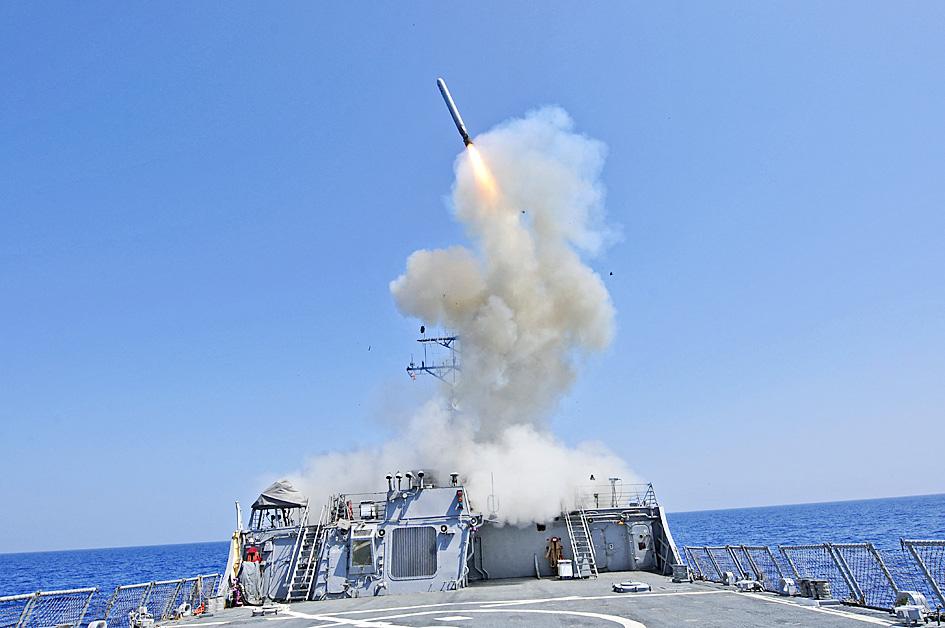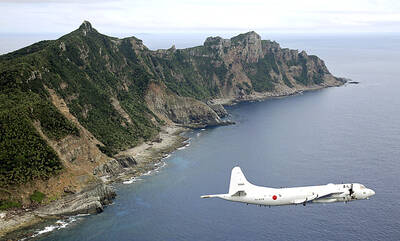A US Navy ship on Friday sailed through the Taiwan Strait, marking the ninth time a US military vessel has transited the Strait since US President Joe Biden took office in January.
The USS Barry, an Arleigh Burke-class guided-missile destroyer, conducted a “routine” transit through the Strait, the US Navy said in a statement, adding that the journey through international waters was conducted “in accordance with international law.”
“The ship’s transit through the Taiwan Strait demonstrates the US’ commitment to a free and open Indo-Pacific,” the US Navy said. “The United States military flies, sails and operates anywhere international law allows.”

Photo: AFP
The Ministry of National Defense yesterday confirmed the transit, saying the US destroyer sailed from north to south through the Strait.
The ministry said it has a grasp of the situation and uses joint intelligence, surveillance and reconnaissance tools to monitor the waters and airspace around Taiwan.
The situation was “normal” while the ship traveled through the Strait, it added.
The destroyer was in the Strait on the same day that 10 Chinese military aircraft flew into Taiwan’s air defense identification zone.
It was the 15th consecutive day that Chinese military aircraft had entered the area.
The military maneuvers are seen by some as a way for Beijing to indicate its displeasure with Taipei and warn against actions it sees as jeopardizing its hopes of annexing Taiwan.
Taipei considers such moves military threats.
On Aug. 27, the USS Kidd, an Arleigh Burke-class guided-missile destroyer, accompanied by the USCGC Munro, conducted what the US Navy called “routine transits” through the Strait.
The USS John S. McCain sailed through the Strait on Feb. 4 and April 7; the USS Curtis Wilbur on Feb. 24, May 18 and June 22; the USS John Finn on March 10; and the USS Benfold on July 28.
The most recent passage came as Taiwan concluded its annual Han Kuang military exercises and China conducted military exercises in waters near Taiwan’s southwest coast.
The Chinese People’s Liberation Army (PLA) had on Friday conducted a military drill in waters off southwestern Taiwan and in the skies over the area, the PLA’s official newspaper reported yesterday, citing Shi Yi (施毅), a spokesperson for the PLA Eastern Theater Command.
Shi did not provide specific information regarding the location of the exercise, saying only that the PLA had deployed naval vessels, early warning aircraft and bombers.
The Ministry of National Defense said that Taiwan had a “thorough grasp and assessment” of China’s military exercises.

MISINFORMATION: The generated content tends to adopt China’s official stance, such as ‘Taiwan is currently governed by the Chinese central government,’ the NSB said Five China-developed artificial intelligence (AI) language models exhibit cybersecurity risks and content biases, an inspection conducted by the National Security Bureau (NSB) showed. The five AI tools are: DeepSeek, Doubao (豆包), Yiyan (文心一言), Tongyi (通義千問) and Yuanbao (騰訊元寶), the bureau said, advising people to remain vigilant to protect personal data privacy and corporate business secrets. The NSB said it, in accordance with the National Intelligence Services Act (國家情報工作法), has reviewed international cybersecurity reports and intelligence, and coordinated with the Ministry of Justice Investigation Bureau and the National Police Agency’s Criminal Investigation Bureau to conduct an inspection of China-made AI language

LIMITS: While China increases military pressure on Taiwan and expands its use of cognitive warfare, it is unwilling to target tech supply chains, the report said US and Taiwan military officials have warned that the Chinese People’s Liberation Army (PLA) could implement a blockade within “a matter of hours” and need only “minimal conversion time” prior to an attack on Taiwan, a report released on Tuesday by the US Senate’s China Economic and Security Review Commission said. “While there is no indication that China is planning an imminent attack, the United States and its allies and partners can no longer assume that a Taiwan contingency is a distant possibility for which they would have ample time to prepare,” it said. The commission made the comments in its annual

‘TROUBLEMAKER’: Most countries believe that it is China — rather than Taiwan — that is undermining regional peace and stability with its coercive tactics, the president said China should restrain itself and refrain from being a troublemaker that sabotages peace and stability in the Indo-Pacific region, President William Lai (賴清德) said yesterday. Lai made the remarks after China Coast Guard vessels sailed into disputed waters off the Senkaku Islands — known as the Diaoyutai Islands (釣魚台) in Taiwan — following a remark Japanese Prime Minister Sanae Takaichi made regarding Taiwan. Takaichi during a parliamentary session on Nov. 7 said that a “Taiwan contingency” involving a Chinese naval blockade could qualify as a “survival-threatening situation” for Japan, and trigger Tokyo’s deployment of its military for defense. Asked about the escalating tensions

DISPUTE: A Chinese official prompted a formal protest from Tokyo by saying that ‘the dirty head that sticks itself out must be cut off,’ after Takaichi’s Taiwan remarks Four armed China Coast Guard vessels yesterday morning sailed through disputed waters controlled by Japan, amid a diplomatic spat following Japanese Prime Minister Sanae Takaichi’s comments on Taiwan. The four ships sailed around the Senkaku Islands — known as the Diaoyutai Islands (釣魚台) to Taiwan, and which Taiwan and China also claim — on Saturday before entering Japanese waters yesterday and left, the Japan Coast Guard said. The China Coast Guard said in a statement that it carried out a “rights enforcement patrol” through the waters and that it was a lawful operation. As of the end of last month,